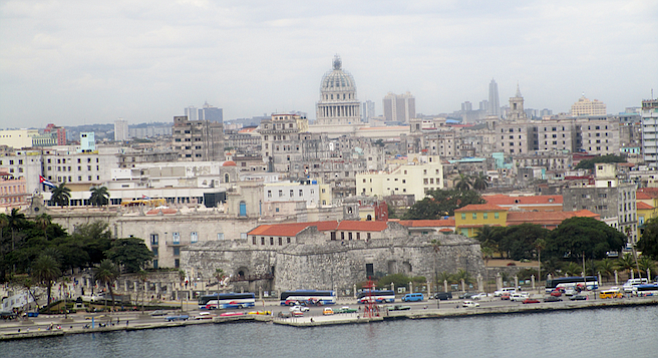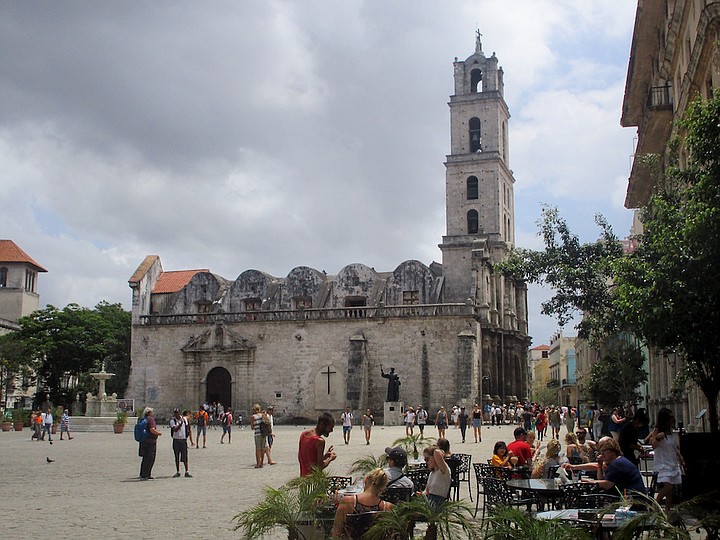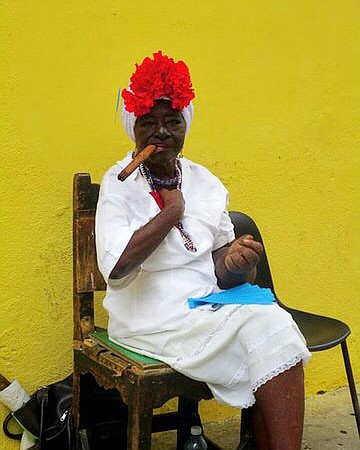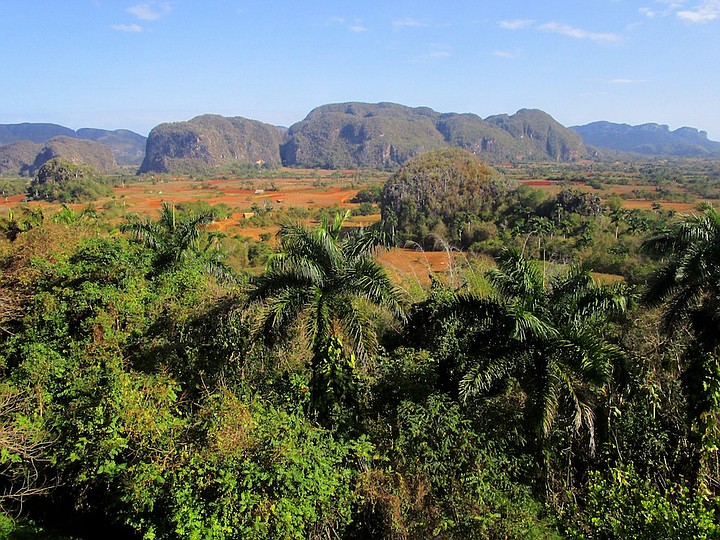 Facebook
Facebook
 X
X
 Instagram
Instagram
 TikTok
TikTok
 Youtube
Youtube

Late afternoon in Havana: Local schoolboys are playing soccer in the central square of the recently renovated Plaza Vieja. Colorful, historic buildings ring the plaza. A warm tropical breeze wafts through the air and the steady beat of a salsa band reinforces the festive atmosphere.
I am waiting for my driver, Paco, and his 1950 Plymouth, but there’s no rush. I recline and soak in the atmosphere of this enchanting city that was taboo to Americans for over half a century.
In 2015, Cuba welcomed 2 million overseas visitors, but in 2016, after President Obama restored diplomatic relations, the number of visitors doubled to 4 million. This influx of sightseers and their dollars is welcomed by the Cuban people and shows no signs of slowing down. It is, however, creating a strain on their aging infrastructure, a shock to the system. Despite this, a visit to Havana, even for a few days, is certain to provide an abundance of thrills and surprises.
Following Rick Steves's advice, I hired a local driver in lieu of taking taxis to get a local perspective on the city. Paco was not a professional driver/ tour guide, but rather a cardiologist who took this job to make extra money for his family. He gave me a window into his personal life, some various cultural insights, and could identify the make, model and year of nearly every classic '50s American car we spotted on the road. Paco swooned with delight at the sight of a 1955 Chevrolet Bel-Air, his favorite.
“You know more about classic American cars than most Americans,” I told him.
Staying with a local family is now my favorite way to travel, and this was no exception. I rented a casa particular, the Cuban term for a private accommodation, through AirBnB, and paid $90 for four nights in a spartan, but comfortable room. Some of the best meals I had in Cuba were cooked by my house mother — wonderful rich soups, meals with fish, beans, rice, and vegetables. Don’t miss the arroz congrí and the “sleeping black beans” when you visit. The Cuban cuisine was rather maligned in the descriptions I read before my trip, but I can’t remember a bad meal I had there.
One of the family members at my casa particular, a professor of literature at Havana University, was happy to help with some books and movies I should investigate to better understand contemporary Cuban life and culture. His author picks: Jorge Enrique Lage, Pedro Juan Gutierrez and Anisley Negrin. He also recommended the movie Santa y Andres, which explores Cuban perspectives on the LGBT community. My driver, Paco, offered more mainstream literary choices: Jose Marti, the national hero, and the poet Nicholas Guillen.
The area of prime interest for your visit to Havana will likely be the old, historic section: Habana Vieja (Old Havana), a UNESCO World Heritage site. This section of Havana will most likely occupy the majority of your time if you are in Cuba for a few days. There are many layers of history to Cuba, and Habana Vieja is the epicenter — from Cuba’s experience as a Spanish colony to its burgeoning independence to the post-Revolutionary period.

The walking tour I took to better understand Havana's past provided a great opportunity to explore Habana Vieja’s many picturesque plazas. Each has its own particular history and ambience. Paco and my walking tour guide both identified and explained several historic sites, buildings and statues in and around the plazas. Plaza del Armas features a large statue of Cuba’s first president after centuries of Spanish rule, Carlos Manuel de Céspedes. This square evokes Cuba’s national history and pride. Plaza de la Catedral and Plaza de San Francisco offer beautiful cathedrals and museums, and my favorite plaza, the recently restored Plaza Vieja, dazzles with its colorful and eclectic architecture. Be sure to take the elevator to the top of Camera Obscura in Plaza Vieja to enjoy one of the best panoramic views of Habana Vieja — step inside a darkened room to catch an impressive live-action view of the city.
It was a pleasure to explore pedestrian-only Calle Obispo, poking my nose in art galleries and souvenir shops. We sipped mojitos on the rooftop of Hemingway’s hotel, Ambos Mundos, and passed his favored bar for mojitos, El Bodeguita del Medio, and his favorite for daiquiris, El Floridita.
I discussed the works of Wilfredo Lam and a myriad of modern Cuban painters with Paco in the Bellas Artes Museum, the premier art museum in Cuba. The Museo de la Revolucion provided a mesmerizing look at Cuban history in the years around and after the Revolution.
My favorite part of the trip was my interaction with the locals. The guide on my three-hour walking tour of Habana Vieja offered additional insights into the restrictions still endured by locals, particularly their inability to travel overseas. She had been a pilot and had flown overseas but was restricted to the airports and could not further explore the cities she visited. One of the American visitors on the walking tour was taken aback. “Excuse my ignorance, but I didn’t know that Cuban people weren’t allowed to travel overseas,” she sheepishly admitted.
“Yes, I’m not allowed,” was the guide’s wistful reply.
“If you could travel anywhere, where would you like to go?” I asked her.
Her reply was quick and emphatic.
“To Miami to see my brother.”
Several times during my walks, Cubans would ask me where I’m from. More than once, when I said California, their eyes lit up and they would tell me about a brother, sister, or other family member who is living in California. Undoubtedly they have similar hopes and wishes as my walking tour guide.
One is struck by the contradictions of Cuban society when conversing with locals about their lifestyles. On the positive side, they have access to free health care and free education, resulting in a well-educated populace. The locals take great pride in this. The people, however, including professionals, are not allowed to travel, receive low wages and have little access to the internet, along with other restrictions on their freedom. The locals I encountered were quite friendly and loved the postcards of San Diego and California I brought as a gesture of international goodwill and friendship.

Other assorted highlights of my walks abut Habana Vieja:
*Classic American cars parked in front of The Gran Teatro (Grand Theater) with the Capitolio in the background.
*A woman posing in front of the Museo Revolucion with a huge cigar, asking me to take her photo and offering me a high five afterward.
*Statues of Abraham Lincoln in the Park Fraternity near the Capitolio and in the Museo de la Revolucion. As many as 60 percent of the Cuban population are descended from slaves, so perhaps this accounts for the locals’ apparent respect for him. Cespedes, Cuba’s first President, freed Cuba’s slaves in 1868, just a few years after the Emancipation Proclamation. Also, Fidel Castro apparently highly respected Lincoln and laid a wreath at the Lincoln Memorial shortly after attaining power in 1959.
*The street musicians and a particular street comic performer with little dogs that wear glasses, chew on Cuban cigars, love visitors, but are trained to growl upon hearing the word, “Trump.”
*The constant stream of 50’s American classic cars used as taxis which contributed to my sensation that I had entered a time warp.
*An elderly fisherman plying his trade along the Malecón, the seaside walkway and wall which stretches for 8km along the coast.
My most anticipated visit to a location of interest in Havana outside of Habana Vieja was to Finca Vigía , the hilltop home of Ernest Hemingway. My trip there took me through a working-class section of Havana that fascinated me with its aging buildings, bustling vegetable markets and pothole-ridden side streets. The items in the interior of Hemingway’s residence remain eerily just the way he left them when he was forced to flee during the revolution. Hemingway loved Cuba, and it is said that not being able to return there contributed to the depression which resulted in his suicide.
On the way back to Old Havana, we stopped by John Lennon Park. Here, Beatles fans can snuggle and take selfies with the life-size statue of John Lennon seated on a park bench. Make sure your driver understands to take you here and not to Parque Lenin, which is quite different (heh heh).

After a few days exploring Havana, I took a day trip to Viñales to enjoy the beautiful valley there with its limestone mogotes and watch the making of the famous Cuban cigars. There are many casas particulares in Viñales and it’s easy to arrange an overnight room. No matter where you stay, be sure to make a stop at Hotel Jazminas for a breathtaking panoramic view of the valley. Despite my limited time in Cuba, I was glad I took a side trip to Viñales to get a taste, however fleeting, of rural life in Cuba.
You'll have to prepare for a trip to Cuba like few trips you have taken. Estimate the amount of cash you’ll need on your trip, and bring more than this amount, as your bank debit and credit cards cannot be used in Cuba. It’s also a good idea to change your American dollars into euros or Canadian dollars before entering Cuba as there’s a 10 percent penalty to exchange American dollars on top of the 3 percent exchange rate. Internet coverage is spotty and expensive. It can be difficult to find reliable WiFi, even in the most exclusive hotels.
Once the internet is more accessible to visitors and credit cards and ATMs can be comfortably used to obtain cash, more visitors will undoubtedly be attracted to visit this enchanting island nation.
Despite these inconveniences, a visit to Cuba, even for a few days, can be a magical experience. It certainly was for me, one of the most memorable excursions of my life.
6/17 UPDATE: On May 30, it was reported that President Trump is planning to roll back Obama-era policies relaxing ties with Cuba, perhaps as soon as June. John Kuvalich, from the US-Cuba Trade and Economic Council, said this would likely include an “increased enforcement related to travel.” This tightening of the travel rules may complicate your upcoming trip to Cuba, including the possibility President Trump will disallow travelers to “self-license” their trip by selecting one of 12 categories of travel as current law allows. Stay tuned for further details.
My hope is that, despite such a policy reversal, relations between the Cuban and American people will continue to evolve. One of the most memorable moments of my trip was that of the photo my driver showed me of his children holding up the California and San Diego postcards I brought. It is this younger generation that offers hope for the future.


Late afternoon in Havana: Local schoolboys are playing soccer in the central square of the recently renovated Plaza Vieja. Colorful, historic buildings ring the plaza. A warm tropical breeze wafts through the air and the steady beat of a salsa band reinforces the festive atmosphere.
I am waiting for my driver, Paco, and his 1950 Plymouth, but there’s no rush. I recline and soak in the atmosphere of this enchanting city that was taboo to Americans for over half a century.
In 2015, Cuba welcomed 2 million overseas visitors, but in 2016, after President Obama restored diplomatic relations, the number of visitors doubled to 4 million. This influx of sightseers and their dollars is welcomed by the Cuban people and shows no signs of slowing down. It is, however, creating a strain on their aging infrastructure, a shock to the system. Despite this, a visit to Havana, even for a few days, is certain to provide an abundance of thrills and surprises.
Following Rick Steves's advice, I hired a local driver in lieu of taking taxis to get a local perspective on the city. Paco was not a professional driver/ tour guide, but rather a cardiologist who took this job to make extra money for his family. He gave me a window into his personal life, some various cultural insights, and could identify the make, model and year of nearly every classic '50s American car we spotted on the road. Paco swooned with delight at the sight of a 1955 Chevrolet Bel-Air, his favorite.
“You know more about classic American cars than most Americans,” I told him.
Staying with a local family is now my favorite way to travel, and this was no exception. I rented a casa particular, the Cuban term for a private accommodation, through AirBnB, and paid $90 for four nights in a spartan, but comfortable room. Some of the best meals I had in Cuba were cooked by my house mother — wonderful rich soups, meals with fish, beans, rice, and vegetables. Don’t miss the arroz congrí and the “sleeping black beans” when you visit. The Cuban cuisine was rather maligned in the descriptions I read before my trip, but I can’t remember a bad meal I had there.
One of the family members at my casa particular, a professor of literature at Havana University, was happy to help with some books and movies I should investigate to better understand contemporary Cuban life and culture. His author picks: Jorge Enrique Lage, Pedro Juan Gutierrez and Anisley Negrin. He also recommended the movie Santa y Andres, which explores Cuban perspectives on the LGBT community. My driver, Paco, offered more mainstream literary choices: Jose Marti, the national hero, and the poet Nicholas Guillen.
The area of prime interest for your visit to Havana will likely be the old, historic section: Habana Vieja (Old Havana), a UNESCO World Heritage site. This section of Havana will most likely occupy the majority of your time if you are in Cuba for a few days. There are many layers of history to Cuba, and Habana Vieja is the epicenter — from Cuba’s experience as a Spanish colony to its burgeoning independence to the post-Revolutionary period.

The walking tour I took to better understand Havana's past provided a great opportunity to explore Habana Vieja’s many picturesque plazas. Each has its own particular history and ambience. Paco and my walking tour guide both identified and explained several historic sites, buildings and statues in and around the plazas. Plaza del Armas features a large statue of Cuba’s first president after centuries of Spanish rule, Carlos Manuel de Céspedes. This square evokes Cuba’s national history and pride. Plaza de la Catedral and Plaza de San Francisco offer beautiful cathedrals and museums, and my favorite plaza, the recently restored Plaza Vieja, dazzles with its colorful and eclectic architecture. Be sure to take the elevator to the top of Camera Obscura in Plaza Vieja to enjoy one of the best panoramic views of Habana Vieja — step inside a darkened room to catch an impressive live-action view of the city.
It was a pleasure to explore pedestrian-only Calle Obispo, poking my nose in art galleries and souvenir shops. We sipped mojitos on the rooftop of Hemingway’s hotel, Ambos Mundos, and passed his favored bar for mojitos, El Bodeguita del Medio, and his favorite for daiquiris, El Floridita.
I discussed the works of Wilfredo Lam and a myriad of modern Cuban painters with Paco in the Bellas Artes Museum, the premier art museum in Cuba. The Museo de la Revolucion provided a mesmerizing look at Cuban history in the years around and after the Revolution.
My favorite part of the trip was my interaction with the locals. The guide on my three-hour walking tour of Habana Vieja offered additional insights into the restrictions still endured by locals, particularly their inability to travel overseas. She had been a pilot and had flown overseas but was restricted to the airports and could not further explore the cities she visited. One of the American visitors on the walking tour was taken aback. “Excuse my ignorance, but I didn’t know that Cuban people weren’t allowed to travel overseas,” she sheepishly admitted.
“Yes, I’m not allowed,” was the guide’s wistful reply.
“If you could travel anywhere, where would you like to go?” I asked her.
Her reply was quick and emphatic.
“To Miami to see my brother.”
Several times during my walks, Cubans would ask me where I’m from. More than once, when I said California, their eyes lit up and they would tell me about a brother, sister, or other family member who is living in California. Undoubtedly they have similar hopes and wishes as my walking tour guide.
One is struck by the contradictions of Cuban society when conversing with locals about their lifestyles. On the positive side, they have access to free health care and free education, resulting in a well-educated populace. The locals take great pride in this. The people, however, including professionals, are not allowed to travel, receive low wages and have little access to the internet, along with other restrictions on their freedom. The locals I encountered were quite friendly and loved the postcards of San Diego and California I brought as a gesture of international goodwill and friendship.

Other assorted highlights of my walks abut Habana Vieja:
*Classic American cars parked in front of The Gran Teatro (Grand Theater) with the Capitolio in the background.
*A woman posing in front of the Museo Revolucion with a huge cigar, asking me to take her photo and offering me a high five afterward.
*Statues of Abraham Lincoln in the Park Fraternity near the Capitolio and in the Museo de la Revolucion. As many as 60 percent of the Cuban population are descended from slaves, so perhaps this accounts for the locals’ apparent respect for him. Cespedes, Cuba’s first President, freed Cuba’s slaves in 1868, just a few years after the Emancipation Proclamation. Also, Fidel Castro apparently highly respected Lincoln and laid a wreath at the Lincoln Memorial shortly after attaining power in 1959.
*The street musicians and a particular street comic performer with little dogs that wear glasses, chew on Cuban cigars, love visitors, but are trained to growl upon hearing the word, “Trump.”
*The constant stream of 50’s American classic cars used as taxis which contributed to my sensation that I had entered a time warp.
*An elderly fisherman plying his trade along the Malecón, the seaside walkway and wall which stretches for 8km along the coast.
My most anticipated visit to a location of interest in Havana outside of Habana Vieja was to Finca Vigía , the hilltop home of Ernest Hemingway. My trip there took me through a working-class section of Havana that fascinated me with its aging buildings, bustling vegetable markets and pothole-ridden side streets. The items in the interior of Hemingway’s residence remain eerily just the way he left them when he was forced to flee during the revolution. Hemingway loved Cuba, and it is said that not being able to return there contributed to the depression which resulted in his suicide.
On the way back to Old Havana, we stopped by John Lennon Park. Here, Beatles fans can snuggle and take selfies with the life-size statue of John Lennon seated on a park bench. Make sure your driver understands to take you here and not to Parque Lenin, which is quite different (heh heh).

After a few days exploring Havana, I took a day trip to Viñales to enjoy the beautiful valley there with its limestone mogotes and watch the making of the famous Cuban cigars. There are many casas particulares in Viñales and it’s easy to arrange an overnight room. No matter where you stay, be sure to make a stop at Hotel Jazminas for a breathtaking panoramic view of the valley. Despite my limited time in Cuba, I was glad I took a side trip to Viñales to get a taste, however fleeting, of rural life in Cuba.
You'll have to prepare for a trip to Cuba like few trips you have taken. Estimate the amount of cash you’ll need on your trip, and bring more than this amount, as your bank debit and credit cards cannot be used in Cuba. It’s also a good idea to change your American dollars into euros or Canadian dollars before entering Cuba as there’s a 10 percent penalty to exchange American dollars on top of the 3 percent exchange rate. Internet coverage is spotty and expensive. It can be difficult to find reliable WiFi, even in the most exclusive hotels.
Once the internet is more accessible to visitors and credit cards and ATMs can be comfortably used to obtain cash, more visitors will undoubtedly be attracted to visit this enchanting island nation.
Despite these inconveniences, a visit to Cuba, even for a few days, can be a magical experience. It certainly was for me, one of the most memorable excursions of my life.
6/17 UPDATE: On May 30, it was reported that President Trump is planning to roll back Obama-era policies relaxing ties with Cuba, perhaps as soon as June. John Kuvalich, from the US-Cuba Trade and Economic Council, said this would likely include an “increased enforcement related to travel.” This tightening of the travel rules may complicate your upcoming trip to Cuba, including the possibility President Trump will disallow travelers to “self-license” their trip by selecting one of 12 categories of travel as current law allows. Stay tuned for further details.
My hope is that, despite such a policy reversal, relations between the Cuban and American people will continue to evolve. One of the most memorable moments of my trip was that of the photo my driver showed me of his children holding up the California and San Diego postcards I brought. It is this younger generation that offers hope for the future.
Comments